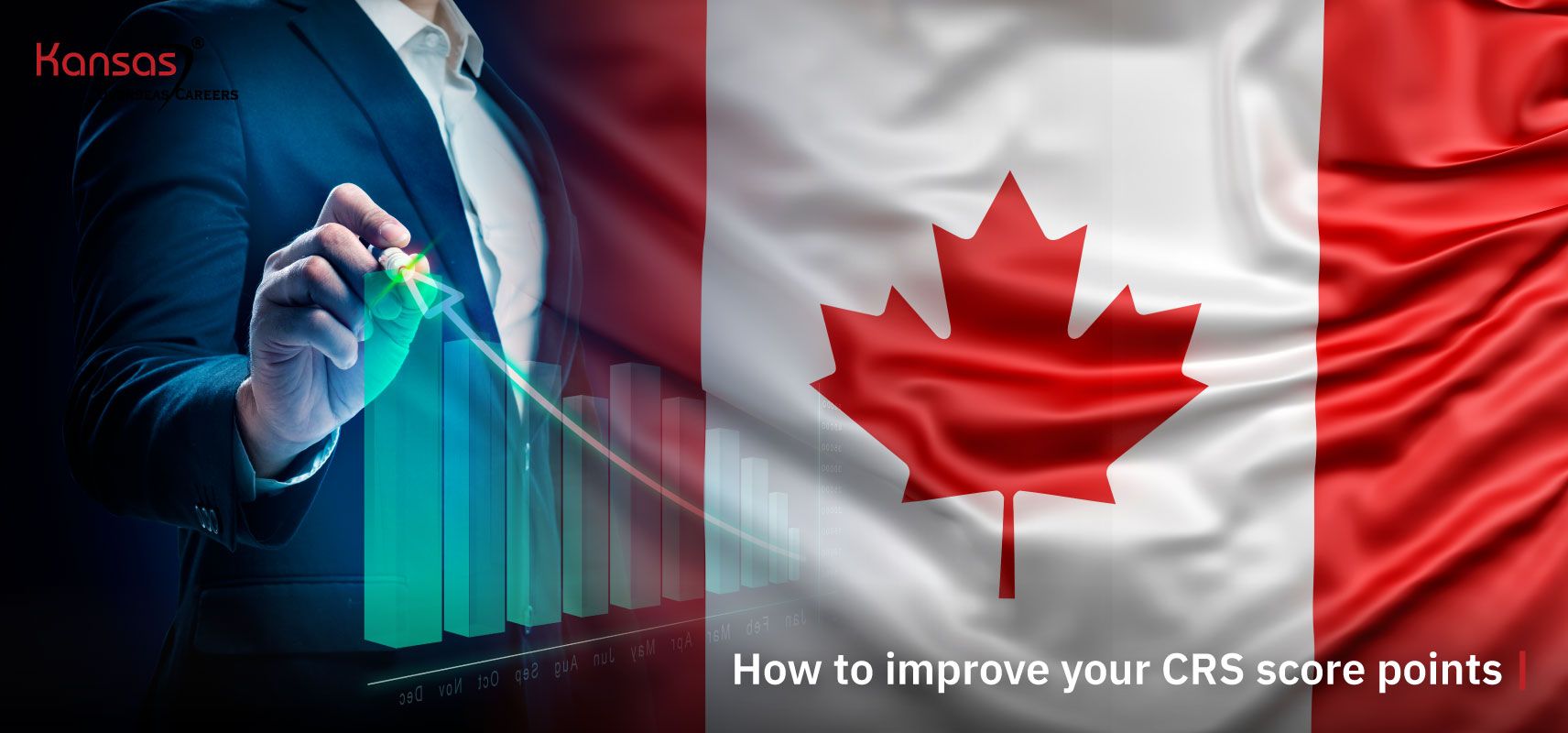The Express Entry Comprehensive Ranking System (CRS) is a points-based system used to rank candidates in the Express Entry pool.

A CRS Calculator is a tool that helps you determine your Comprehensive Ranking System (CRS) score for Express Entry. The CRS score is a points-based system used to evaluate and rank your profile based on factors like skills, education, language ability, and work experience.
By answering questions in the calculator, you can see how your profile ranks compared to others in the Express Entry pool.

The Comprehensive Ranking System (CRS) is used to rank candidates for immigration to Canada through the Express Entry program. Here is an overview:
The CRS assigns points based on:
The CRS gives you a total score out of 1,200 points, divided into core points and additional points.
Core Points (Up to 600):
Additional Points (Up to 600):
Total Score = Core Points + Additional Points
Express Entry is a points-based system used by Canada to assess skilled workers who want to apply for permanent residence.
It is a two-step process that evaluates candidates for three federal economic immigration programs. First, applicants submit an online profile with details like their skills, work experience, and other qualifications. Those who meet the minimum criteria are added to the Express Entry pool. Candidates are then given points (up to 1,200) based on various factors, using the Comprehensive Ranking System (CRS).
Every two weeks, the highest-scoring candidates are invited to apply for immigration programs.
It handles three main programs:

Our CRS Calculator serves as a helpful tool for anyone planning to immigrate to Canada, whether you're already in the country or not. By entering basic information like your age, education, language skills, and work experience, the calculator provides an estimate of your Comprehensive Ranking System (CRS) score.
It's a simple way to get an idea of where you stand in the immigration process.
In the latest Express Entry draw on April 10th, 1,280 people were invited to become permanent residents. They needed a Comprehensive Ranking System (CRS) score of at least 549 to qualify.
|
Category |
Without Spouse/Common-Law Partner |
With Spouse/Common-Law Partner |
|
Core Human Capital Factors |
Up to 500 points |
Up to 460 points (Principal Applicant) |
|
|
|
Up to 40 points (Spouse/Common-Law Partner) |
|
Skill Transferability Factors |
Up to 100 points |
Up to 100 points |
|
Provincial Nomination |
600 points |
600 points |
|
Arranged Employment Offer |
Up to 200 points |
Up to 200 points |
|
Canadian Study Experience |
Up to 30 points |
Up to 30 points |
|
French Language Ability (combined with English) |
Up to 50 points |
Up to 50 points |
|
Sibling in Canada |
Up to 15 points |
Up to 15 points |
|
CRS Score Range |
Message |
|
0-300 |
Explore alternatives. Candidates with lower scores, especially without skilled Canadian work experience, should consider alternative ways to move to Canada. |
|
300-399 |
Provinces may start looking for you. Some provinces, like Alberta, have invited candidates with scores in this range through the Provincial Nominee Program (PNP), which can add 600 points to your score. |
|
400-499 |
Getting better. Small improvements, especially in language skills (aim for CLB 9 or better), can significantly boost your score. Candidates may be invited through category-based draws or additional PNP options. |
|
500-549 |
Competitive. You are in a good position to receive an Invitation to Apply (ITA). However, aim to increase your score further to stay competitive, as some all-program draws have cut-offs above 500. |
|
550+ |
Strong. Congratulations, this is a very competitive score! While not guaranteed, a score above 550+ puts you in a strong position for an invitation. Explore further points-boosting opportunities if needed. |
Points to Note:
Points breakdown, section by section
|
Age |
With a spouse or common-law partner |
Without a spouse or common-law partner |
|
17 years of age or less |
0 |
0 |
|
18 years of age |
90 |
99 |
|
19 years of age |
95 |
105 |
|
20 to 29 years of age |
100 |
110 |
|
30 years of age |
95 |
105 |
|
31 years of age |
90 |
99 |
|
32 years of age |
85 |
94 |
|
33 years of age |
80 |
88 |
|
34 years of age |
75 |
83 |
|
35 years of age |
70 |
77 |
|
36 years of age |
65 |
72 |
|
37 years of age |
60 |
66 |
|
38 years of age |
55 |
61 |
|
39 years of age |
50 |
55 |
|
40 years of age |
45 |
50 |
|
41 years of age |
35 |
39 |
|
42 years of age |
25 |
28 |
|
43 years of age |
15 |
17 |
|
44 years of age |
5 |
6 |
|
45 years of age or more |
0 |
0 |
|
Maximum |
100 |
110 |
|
Level of Education |
With a spouse or common-law partner |
Without a spouse or common-law partner |
|
Less than secondary school (high school) |
0 |
0 |
|
Secondary diploma (high school graduation) |
28 |
30 |
|
One-year degree, diploma or certificate from a university, college, trade or technical school, or other institute |
84 |
90 |
|
Two-year program at a university, college, trade or technical school, or other institute |
91 |
98 |
|
Bachelor's degree OR a three or more year program at a university, college, trade or technical school, or other institute |
112 |
120 |
|
Two or more certificates, diplomas, or degrees. One must be for a program of three or more years |
119 |
128 |
|
Master's degree, OR professional degree needed to practice in a licensed profession (For “professional degree,” the degree program must have been in: medicine, veterinary medicine, dentistry, optometry, law, chiropractic medicine, or pharmacy.) |
126 |
135 |
|
Doctoral level university degree (Ph.D.) |
140 |
150 |
|
Maximum |
140 |
150 |
|
Canadian Language Benchmark (CLB) level per ability |
With a spouse or common-law partner |
Without a spouse or common-law partner |
|
*Points are awarded for each language ability |
||
|
Less than CLB 4 |
0 |
0 |
|
CLB 4 or 5 |
6 |
6 |
|
CLB 6 |
8 |
9 |
|
CLB 7 |
16 |
17 |
|
CLB 8 |
22 |
23 |
|
CLB 9 |
29 |
31 |
|
CLB 10 or more |
32 |
34 |
|
Maximum |
128 |
136 |
|
Canadian Language Benchmark (CLB) level per ability |
With a spouse or common-law partner |
Without a spouse or common-law partner |
|
*Points are awarded for each language ability |
||
|
CLB 4 or less |
0 |
0 |
|
CLB 5 or 6 |
1 |
1 |
|
CLB 7 or 8 |
3 |
3 |
|
CLB 9 or more |
6 |
6 |
|
Maximum |
22 |
24 |
|
Canadian work experience |
With a spouse or common-law partner |
Without a spouse or common-law partner |
|
None or less than a year |
0 |
0 |
|
1 year |
35 |
40 |
|
2 years |
46 |
53 |
|
3 years |
56 |
64 |
|
4 years |
63 |
72 |
|
5 years or more |
70 |
80 |
|
Maximum |
70 |
80 |
Subtotal: A – Core / human capital factors
|
Spouse’s or common-law partner’s level of education |
With spouse or common-law partner |
Without spouse or common-law partner |
|
Less than secondary school (high school) |
0 |
n/a |
|
Secondary school (high school graduation) |
2 |
n/a |
|
One-year program at a university, college, trade or technical school, or other institute |
6 |
n/a |
|
Two-year program at a university, college, trade or technical in school, or other institute |
7 |
n/a |
|
Bachelor's degree OR a three or more year program at a university, college, trade or technical school, or other institute |
8 |
n/a |
|
Two or more certificates, diplomas, or degrees. One must be for a program of three or more years |
9 |
n/a |
|
Master's degree, or professional degree needed to practice in a licensed profession (For a “professional degree”, the degree program must have been in: medicine, veterinary medicine, dentistry, optometry, law, chiropractic medicine, or pharmacy.) |
10 |
n/a |
|
Doctoral-level university degree (PhD) |
10 |
n/a |
|
Maximum |
10 |
Does Not Apply |
|
Canadian Language Benchmark (CLB) level per ability (reading, writing, speaking and listening) |
With spouse or common-law Partner |
Without spouse or common-law partner |
|
*Points are awarded for each language ability |
||
|
CLB 4 or less |
0 |
n/a |
|
CLB 5 or 6 |
1 |
n/a |
|
CLB 7 or 8 |
3 |
n/a |
|
CLB 9 or more |
5 |
n/a |
|
Maximum |
20 |
Does Not Apply |
|
Spouse's Canadian work experience |
With a spouse or common-law partner |
Without a spouse or common-law partner |
|
None or less than a year |
0 |
n/a |
|
1 year |
5 |
n/a |
|
2 years |
7 |
n/a |
|
3 years |
8 |
n/a |
|
4 years |
9 |
n/a |
|
5 years or more |
10 |
n/a |
|
Maximum |
10 |
Does Not Apply |
Subtotal: A – Core / human capital + B – Spouse or common-law partner factors – Maximum 500 points
|
With good official language proficiency (Canadian Language Benchmark Level [CLB] 7 or higher) and a post-secondary degree |
Points for CLB 7 or more on all first official language abilities, with one or more under CLB 9 |
Points for CLB 9 or more on all four first official language abilities |
|
Secondary school (high school) credential or less |
0 |
0 |
|
Post-secondary program credential of one year or longer |
13 |
25 |
|
Two or more post-secondary program credentials AND at least one of these credentials was issued on completion of a post-secondary program of three years or longer |
25 |
50 |
|
Maximum |
25 |
50 |
|
With Canadian work experience and a post-secondary degree |
Points for education + 1 year of Canadian work experience |
Points for education + 2 years or more of Canadian work experience |
|
Secondary school (high school) credential or less |
0 |
0 |
|
Post-secondary program credential of one year or longer |
13 |
25 |
|
Two or more post-secondary program credentials AND at least one of these credentials was issued on completion of a post-secondary program of three years or longer |
25 |
50 |
|
Maximum |
25 |
50 |
|
Years of experience |
Points for foreign work experience + CLB 7 or more on all first official language abilities, one or more under 9 |
Points for foreign work experience + CLB 9 or more on all four first official language abilities |
|
No foreign work experience |
0 |
0 |
|
1 or 2 years of foreign work experience |
13 |
25 |
|
3 years or more of foreign work experience |
25 |
50 |
|
Maximum |
25 |
50 |
|
Years of experience |
Points for foreign work experience + 1 year of Canadian work experience |
Points for foreign work experience + 2 years or more of Canadian work experience |
|
No foreign work experience |
0 |
0 |
|
1 or 2 years of foreign work experience |
13 |
25 |
|
3 years or more of foreign work experience |
25 |
50 |
|
Maximum |
25 |
50 |
Subtotal: A – Core / human capital + B – Spouse or common-law partner + C – Skill transferability factors – Maximum 600 points
|
Factor |
Points |
|
Brother or sister living in Canada (citizen or permanent resident) |
15 |
|
French language skills |
50 |
|
Post-secondary education in Canada |
30 |
|
Arranged employment |
200 |
|
PN nomination |
600 |
|
Maximum |
600 |
|
A. Core/human capital + B. Spouse or common-law partner factors + C. Transferability factors + D. Additional points = Grand total – Maximum 1,200 points |
|

Boosting your CRS score in Express Entry is crucial for Canadian permanent residency. A higher score increases your chances of receiving an Invitation to Apply (ITA). Here's how to improve your score:
To increase your CRS score through the Provincial Nominee Program (PNP), apply to any PNP to potentially add 600 points. Ensure you meet eligibility criteria and have an Express Entry account.
Eligible applicants for multiple Express Entry programs are invited based on this order:
Provinces have innovatively used their Express Entry-aligned PNP streams:
A good CRS score enables Canadian authorities to consider your application for a Permanent Residency (PR) visa.
The Comprehensive Ranking System (CRS) score is pivotal in every Express Entry draw. It ranks candidates across all three categories to determine invitations.
Federal Express Entry Draws: The Federal Skilled Worker Program (FSW) typically has bi-weekly draws with lower CRS score requirements.
Provincial Nominee Program: PNP nomination can earn you up to 600 extra CRS points, significantly affecting your score.
Canadian Experience Class: CEC is ideal for those with at least one year of Canadian work experience seeking permanent residence in Canada.
The NOC code can affect the CRS score as it has different categories. As per Citizenship and Immigration Canada (CIC),
NOC code is of two categories –
Only the applicants choosing the NOC skilled category can get CRS points for work experience. The other categories do not get this benefit.
But, the NOC category 00 can get a maximum point of 875.
To choose the right NOC if you fit multiple categories, you must consider some factors. These are –
To apply for a Provincial Nominee Program (PNP) through the Express Entry system, you have two options:
Submit an Expression Of Interest (EOI) to the suitable PNP.
For employees:
For self-employed:
If you have Canadian work experience:
Proof of completed studies, whether in Canada or abroad, may include:
Your letter of employment should contain:
Include a copy of your provincial/territorial certificate of qualification.
The Comprehensive Ranking System (CRS) is a points-based system that Canada uses to assess candidates for immigration through programs like the Federal Skilled Worker, Federal Skilled Trades, and Canadian Experience Class.
This program is for skilled workers who have gained experience working in Canada within the last three years. It's tailored for individuals who have already integrated into the Canadian workforce.
Geared towards skilled workers with foreign work experience, this program has specific educational and eligibility criteria. It's ideal for individuals with expertise gained outside of Canada.
This program is aimed at skilled workers specializing in a qualified trade. It requires either a valid job offer or a certificate of qualification. It's a great option for those skilled in various trades like carpentry or plumbing.
In addition to these programs, candidates eligible for Express Entry can also apply for the Provincial Nominee Program (PNP). This allows them to earn additional points and increases their chances of selection by provinces based on their specific labour market needs.
Steps to Understanding the CRS System
Ensure you qualify for one of the immigration programs by meeting criteria in areas like age, education, language skills, and work experience.
Take a language test (like IELTS or CELPIP) for English or French. Your results will convert to Canadian Language Benchmark (CLB) scores, which contribute points to your CRS score.
Get an Educational Credential Assessment (ECA) for your foreign qualifications. Your education level will be converted to its Canadian equivalent, earning you points based on the highest level achieved.
Work experience, especially in skilled occupations classified under National Occupational Classification (NOC), contributes significantly to your CRS score. Points increase with more years of experience.
The younger you are, the more points you earn, with maximum points awarded to those aged 20-29. Points start decreasing after age 30.
Documentation is a crucial part of your Visa process. Our Visa agents will help you do it correctly.
Canada PR application should be processed in 6-8 months. The duration varies based on different factors.
In 2025, the required Comprehensive Ranking System (CRS) score for Canada's Express Entry depends on your occupation due to category-based draws. If your occupation is not targeted in these draws, you should aim for a CRS score of at least 500.
For targeted occupations, like healthcare, the required score is currently around 431, while STEM workers typically need a score of about 486 to receive an invitation to apply for permanent residence. Regardless of your occupation, the goal should be to maximize your CRS points when entering the Express Entry pool.
The tests for English are IELTS (International English Language Testing System) and CELPIP (Canadian English Language Proficiency Index Program). For French, the tests are TEF (Test d'évaluation de français) and TCF (Test de connaissance du français).
There is no minimum CRS score required to submit an Express Entry profile. However, to receive an Invitation to Apply (ITA), your score must meet or exceed the minimum CRS cut-off score in a given draw.
You must disclose any refusals or removals in your application. This does not automatically disqualify you, but you need to provide accurate information and explanations.
The CRS calculator assesses points based on factors like age, education, language ability, work experience, and adaptability. You enter your details into the calculator, and it provides a score to estimate your ranking in the Express Entry pool.
This depends on the individual case. Common tests include IELTS or CELPIP for English, and TEF or TCF for French.
This depends on the Provincial Nominee Program (PNP) you applied to. The specific province or territory will issue the nomination certificate.
A provincial nomination grants an additional 600 points, significantly increasing your chances of receiving an ITA.
This is specific to the individual. You need to calculate and provide the exact number of years of foreign work experience you have.
You can use the official CRS calculator provided by the Government of Canada. Enter your details such as age, education, work experience, language ability, and any additional factors to get your estimated CRS score.
Kansas Overseas Careers Pvt Ltd is NOT a RECRUITMENT / PLACEMENT AGENCY, we neither assist in any kind of Job / employment offers nor do guarantee any kind of domestic/International placements.